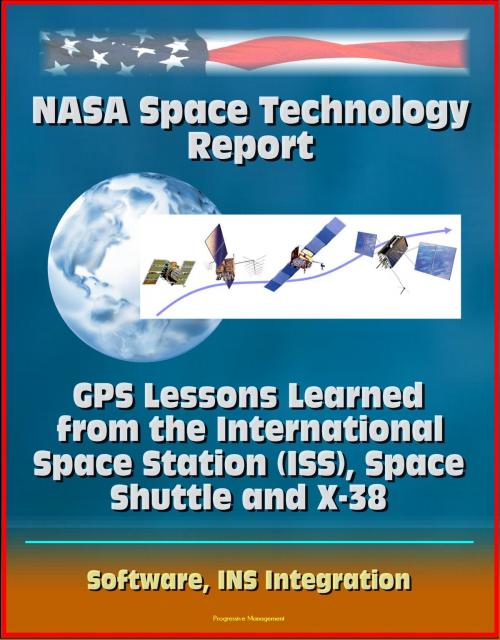NASA Space Technology Report: GPS Lessons Learned from the International Space Station (ISS), Space Shuttle and X-38, Software, INS Integration
Nonfiction, Science & Nature, Technology, Aeronautics & Astronautics| Author: | Progressive Management | ISBN: | 9781301427871 |
| Publisher: | Progressive Management | Publication: | April 16, 2013 |
| Imprint: | Smashwords Edition | Language: | English |
| Author: | Progressive Management |
| ISBN: | 9781301427871 |
| Publisher: | Progressive Management |
| Publication: | April 16, 2013 |
| Imprint: | Smashwords Edition |
| Language: | English |
This document is a collection of writings concerning the application of Global Positioning System (GPS) technology to the International Space Station (ISS), Space Shuttle, and X-38 vehicles. An overview of how GPS technology was applied is given for each vehicle, including rationale behind the integration architecture, and rationale governing the use (or non-use) of GPS data during flight. For the convenience of the reader, who may not be interested in specific details of the ISS, Shuttle and X-38 applications, the lessons learned chapter is at the beginning of the document. Most of this material can be understood without reading the sections specific to the ISS, Shuttle and X-38.
In the early 1990s, use of Commercial or Modified Off The Shelf (COTS or MOTS) hardware and software became a prominent theme in government and industry in order to reduce procurement, development and integration costs. At the same time, in an attempt to revitalize the U.S. space program, a "faster-better-cheaper" approach to spacecraft development and mission execution was being stressed within NASA.
By the early 1990s, after over 20 years of development of the Global Positioning System, the GPS satellite network and associated ground support infrastructure was nearing operational status. GPS receivers for scientific, commercial, consumer and military applications were entering the marketplace. GPS was anticipated to provide the revolutionary capability of precision navigation at low cost and at a minimum amount of effort on the part of the user. GPS receivers have the potential to provide cheaper, more accurate and timelier state vectors than traditional ground tracking. GPS is an enabling technology for small satellites operated by organizations that cannot support an operations infrastructure. To lower spacecraft operating costs, there is a desire to build spacecraft that operate in a more autonomous fashion and require fewer or no ground support personnel.
At this time, the NASA Johnson Space Center initiated a number of projects designed to leverage GPS technology to meet the needs of current and future manned spacecraft. Use of off-the-shelf GPS receivers was believed to be the key to introducing low cost, precision navigation into human space flight, and to reduce integration, certification, and maintenance costs. These spacecraft included the Space Shuttle, the ISS and the X-38, a prototype of a Crew Return Vehicle (CRV) for the ISS. While the Shuttle and ISS integrations were successful (the X-38 was canceled), more technical and project management challenges were encountered than anticipated. More GPS receiver software changes, host vehicle flight software changes, and flight and ground testing were required than anticipated, which in turn caused schedules to slip.
This document is a collection of writings concerning the application of Global Positioning System (GPS) technology to the International Space Station (ISS), Space Shuttle, and X-38 vehicles. An overview of how GPS technology was applied is given for each vehicle, including rationale behind the integration architecture, and rationale governing the use (or non-use) of GPS data during flight. For the convenience of the reader, who may not be interested in specific details of the ISS, Shuttle and X-38 applications, the lessons learned chapter is at the beginning of the document. Most of this material can be understood without reading the sections specific to the ISS, Shuttle and X-38.
In the early 1990s, use of Commercial or Modified Off The Shelf (COTS or MOTS) hardware and software became a prominent theme in government and industry in order to reduce procurement, development and integration costs. At the same time, in an attempt to revitalize the U.S. space program, a "faster-better-cheaper" approach to spacecraft development and mission execution was being stressed within NASA.
By the early 1990s, after over 20 years of development of the Global Positioning System, the GPS satellite network and associated ground support infrastructure was nearing operational status. GPS receivers for scientific, commercial, consumer and military applications were entering the marketplace. GPS was anticipated to provide the revolutionary capability of precision navigation at low cost and at a minimum amount of effort on the part of the user. GPS receivers have the potential to provide cheaper, more accurate and timelier state vectors than traditional ground tracking. GPS is an enabling technology for small satellites operated by organizations that cannot support an operations infrastructure. To lower spacecraft operating costs, there is a desire to build spacecraft that operate in a more autonomous fashion and require fewer or no ground support personnel.
At this time, the NASA Johnson Space Center initiated a number of projects designed to leverage GPS technology to meet the needs of current and future manned spacecraft. Use of off-the-shelf GPS receivers was believed to be the key to introducing low cost, precision navigation into human space flight, and to reduce integration, certification, and maintenance costs. These spacecraft included the Space Shuttle, the ISS and the X-38, a prototype of a Crew Return Vehicle (CRV) for the ISS. While the Shuttle and ISS integrations were successful (the X-38 was canceled), more technical and project management challenges were encountered than anticipated. More GPS receiver software changes, host vehicle flight software changes, and flight and ground testing were required than anticipated, which in turn caused schedules to slip.















